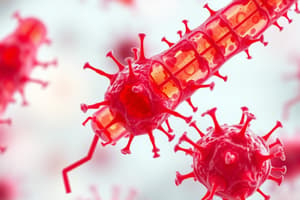Podcast
Questions and Answers
What is the primary method by which Mycobacterium intracellulare demonstrates pathogenicity?
What is the primary method by which Mycobacterium intracellulare demonstrates pathogenicity?
- Production of exotoxins
- Adherence to host tissues (correct)
- Increased transmission through aerosols
- Resistance to all types of immune responses
Which of the following is a characteristic of bacterial adherence?
Which of the following is a characteristic of bacterial adherence?
- It occurs via production of antibodies.
- It involves binding between adhesins and host receptors. (correct)
- It relies on biofilm formation.
- It always leads to bacterial invasion.
What type of transmission does not apply to Mycobacterium intracellulare?
What type of transmission does not apply to Mycobacterium intracellulare?
- Respiratory transmission
- Sexual contact transmission
- Fecal-oral transmission (correct)
- Maternal-placental-neonatal transmission
Which of the following factors is attributed to the virulence of certain bacterial strains?
Which of the following factors is attributed to the virulence of certain bacterial strains?
What is the lethal dose (LD50) of botulinum toxin?
What is the lethal dose (LD50) of botulinum toxin?
What is the primary function of adhesins in the process of microbial infection?
What is the primary function of adhesins in the process of microbial infection?
How do pathogens typically exit the body after causing disease?
How do pathogens typically exit the body after causing disease?
What role do siderophores play in microbial pathogenicity?
What role do siderophores play in microbial pathogenicity?
Which mechanism do pathogens use to alter their surface antigens in order to evade the host's immune system?
Which mechanism do pathogens use to alter their surface antigens in order to evade the host's immune system?
What are the functions of the cell wall components in invading microbes?
What are the functions of the cell wall components in invading microbes?
Flashcards are hidden until you start studying
Study Notes
Pathogen Interaction with Host
- Pathogens must adhere to tissues, penetrate or evade defenses, and damage host tissues to cause disease.
- Specific portals of exit usually correspond to portals of entry (e.g., mucous membranes, skin).
Determinants of Pathogenicity
- Virulence factors include:
- Bacterial adherence
- Tissue specificity
- Invasiveness
- Production of toxins
- Antiphagocytic factors and immune evasion strategies
- Siderophore production to sequester iron
Microbial Transmission Patterns
- Routes include:
- Respiratory transmission via aerosols
- Fecal-oral
- Direct contact with lesions or fomites
- Bloodborne transmission
- Sexual contact and maternal-neonatal transmission
Adherence Mechanism
- Pathogens use adhesins (ligands) to bind to host receptors.
- Common adhesion structures: Glycocalyx and fimbriae (pili), contributing to biofilm formation for nutrient sharing.
Tissue Affinity Examples
- Streptococcus mutans attacks tooth enamel.
- Streptococcus salivarius resides on the tongue surface.
- Streptococcus pyogenes colonizes pharyngeal epithelium.
Invasiveness Mechanisms
- Bacteria employ enzymes such as:
- Hyaluronidase to dissolve connective tissue
- Collagenase to hydrolyze muscle connective tissues
- Streptokinase to lyse blood clots
- Hemolysins to lyse red and white blood cells
Key Terminologies
- ID50: Infectious dose required to infect 50% of a population, indicates virulence.
- LD50: Lethal dose for 50% of a population, assesses toxin potency.
Toxin Production
- Toxins can produce a range of effects, including fever, shock, and organ damage.
- Two main types:
- Endotoxins (LPS from Gram-negative bacteria)
- Exotoxins produced and secreted by bacteria.
Endotoxin Characteristics
- Lipid A portion of LPS released during pathogen death triggers immune responses.
- Can cause disseminated intravascular coagulation and other systemic effects.
Immune Response Dynamics
- Macrophages detect Gram-negative bacteria and release cytokines leading to systemic symptoms and fever.
Normal Flora Significance
- Bacterial floras contribute to host immunity and regulate pathogenicity.
- Disruption through trauma or antibiotic use can lead to opportunistic infections.
Clinical Cases of Pathogen Interactions
- Overgrowth of normal flora can cause infections in certain contexts, such as Streptococcus viridans following dental procedures leading to endocarditis.
- Antibiotic-resistant pathogens can thrive after disturbance of normal flora balance.
Role of Gut Microbiota
- Gut microbiota plays a role in neurodegenerative diseases through the gut-brain axis.
- Helps in vitamin synthesis (e.g., B & K vitamins) and maintains a balanced immune response.
Immune Evasion Mechanisms
- Certain bacteria, such as Mycobacterium tuberculosis, evade immune detection by inhibiting phagosome-lysosome fusion, allowing persistence in host cells.
- T-cell activation is crucial in controlling infections by promoting cytokine release.
Educational Review Points
- Understand infection mechanisms, normal flora, and their regulatory roles.
- Apply this knowledge to clinical case studies regarding infection and pathogen interactions.
Studying That Suits You
Use AI to generate personalized quizzes and flashcards to suit your learning preferences.





